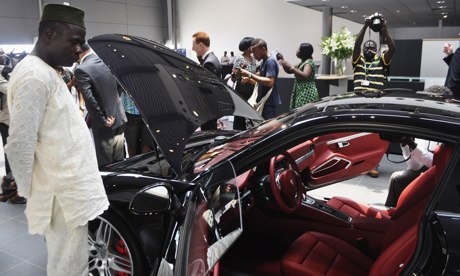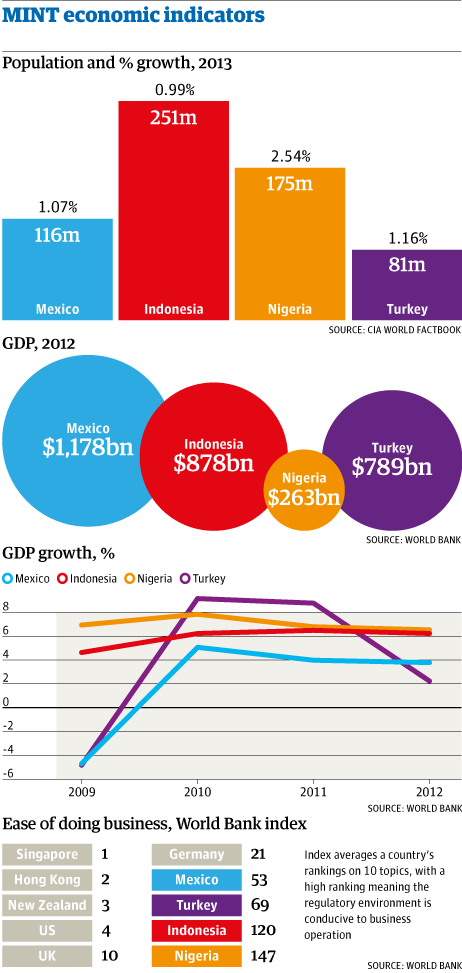O’Neill, Man Who Coined ‘BRICs,’ Still Likes BRICs, But Likes MINTs, Too
http://blogs.wsj.com/moneybeat/2013/12/09/oneill-man-who-coined-brics-still-likes-brics-but-likes-mints-too/
By Luciana Magalhaes and Matthew Cowley
Dec 9, 2013

SÃO PAULO–The creator of the BRIC acronym says he hasn’t always been an optimist, but right now his enthusiasm for the global economy is running sky-high.
“During the 1990s I was bearish about the world because I was very worried about the U.S. current account,” Jim O’Neill said in a telephone interview on Friday.
That changed in the 2000s, when he first coined the BRIC acronym, and this decade is also looking bright, he says. “In some respects it is all about the U.S. and China swapping places, and it’s happening,” says Mr. O’Neill.
Manufacturing in the U.S. is starting to recover, while China is exporting less and driving up domestic demand. That makes for a healthier balance in the global economy.
“Compared to most people I speak to I seem to be still a lot more optimistic but it is a fallacy that I’ve always been optimistic.”
The former chief economist at Goldman Sachs — who left the bank earlier this year — is now taking a look beyond the BRICs to another set of countries likely to shine. That was for a series for BBC Radio about four emerging economies that could rise into the ranks of the top 10 global economies by 2050.
The anointed ones are Mexico, Indonesia, Nigeria and Turkey, or MINT: their uniting themes are favorable demographics and attractive economic prospects.
Yet they will never live up to the BRICs, he says, which will always remain much larger. In two years China alone creates more new wealth than the entire MINT gross domestic product combined. The largest economies in the MINTs are Mexico and Turkey, neither of which are expected to achieve China-like rates of growth, so the average is skewed. Nigeria, the smallest country in the group, is the one with most potential.
Curiously, however, the MINTs may have more in common with each other than the BRICs. While Brazil, Russia, India and China have gone to great ends to come up with a coordinated plan of action at global forums such as the G-20, there are always gaping differences. At last week’s World Trade Organization talks in Bali, India objected to a global trade pact supported by the other three nations.
“Mexico, Indonesia and Turkey all share very multi-dimensional trade patterns,” said Mr. O’Neill. People he spoke to in the MINT countries believe there is more natural affinity among MINTs than BRICs, he said.
The economist projects the BRICs will grow an average for 6.6% in the decade from 2011 to 2020, but that’s almost entirely down to China. He’s jokes that if he had to modify the BRICs at all, it would become the “C” — the only country that’s surpassed his expectations.
He’s very optimistic about the Chinese government’s efforts to move toward better quality growth at the expense of quantity. As a result, the pace of growth in China’s economy has come down somewhat, prompting concerns about the impact on the global economy. Mr. O’Neill says that China growing at a pace of around 7.5% is equivalent to the U.S. growing at 4% per year.
“People still don’t fully appreciate that,” Mr. O’Neill said.
There have been plenty of negative headlines on Brazil, Russia and India in the last few years. But that’s also been overblown, according to the banker. “If those countries show any vague acceleration, it is probably going to surprise people,” he said.
In the case of Brazil, the economist said he won’t be surprised if Brazil grows between 2.5% and 4.5% or 5%, next year. Quite a jump from 2012, when Brazil’s gross domestic product increased a revised 1.5%, still well below initial government projections of 4.5%. Economists in Brazil see growth of around 2.1% next year, according to the central bank’s latest weekly survey.
Mr. O’Neill says Brazil needs to adopt stronger supply side reforms and expects a pick-up in private investment in 2014 to drive a faster pace of growth.
As for China, the economist predicts GDP will probably grow between 7.5 to 8% in 2014.
The Economist Who Invented The BRICs Just Invented A Whole New Group Of Countries: The MINTs
http://www.businessinsider.com/jim-oneill-presents-the-mint-economies-2013-11?IR=T&
MATTHEW BOESLER
- NOV. 13, 2013

Former Goldman Sachs economist Jim O'Neill is the one who popularized the term "BRICs" in reference to the group of emerging-market economies made up of Brazil, Russia, India, and China.
This year, however, the fortunes of those economies have taken a turn for the worse for various reasons, and many investors are abandoning the idea that they will be able to continue the rapid growth that has characterized the past several years.
Much investor attention has therefore shifted from emerging markets to "frontier markets," a classification made up of economies smaller than those of the BRICs.
In a new column for Bloomberg View, O'Neill presents a new potential investment destination: the "MINT" economies (emphasis added):
I spent last week in Indonesia, working on a series for BBC Radio about four of the world’s most populous non-BRIC emerging economies. The BRIC countries -- Brazil, Russia, India and China -- are already closely watched. The group I’m studying for this project -- let’s call them the MINT economies -- deserve no less attention. Mexico, Indonesia, Nigeria and Turkey all have very favorable demographics for at least the next 20 years, and their economic prospects are interesting.
Policy makers and thinkers in the MINT countries have often asked me why I left them out of that first classification. Indonesians made the point with particular force. Over the years I’ve become accustomed to being told that the BRIC countries should have been the BRIICs all along, or maybe even the BIICs. Wasn’t Indonesia’s economic potential more compelling than Russia’s? Despite the size of its relatively young population (a tremendous asset), I thought it unlikely that Indonesia would do enough on the economic-policy front to quickly realize that potential.
"Now, meeting a diverse group of Indonesians — from the leading candidates for the 2014 presidential elections to shoppers in Jakarta’s busy malls — I found a healthy preoccupation with the country’s economic prospects," writes O'Neill. "Could Indonesia do what’s needed to lift the country’s growth rate to 7 percent or more, they were asking, or would it have to settle for 'just' 5 percent?"
Fellow Bloomberg View columnist Matthew C. Klein points out on Twitter that Fidelity actually coined the term "MINT" in 2011:
Read O'Neill's whole column at Bloomberg View, and expect to hear a lot more about the "MINTs" going forward.
Mint condition: countries tipped as the next economic powerhouses
http://www.theguardian.com/business/2014/jan/09/mint-condition-countries-tipped-economic-powerhouses
Forget the Brics and the Civets, Mexico, Indonesia, Nigeria and Turkey are the new kids on the bloc according to economists
9 January 2014

A Nigerian man at a Porsche dealership in Lagos. Nigeria is aiming to become Africa's economic hub. Photograph: Reuters
First it was the Brics. For a while the Civets were in vogue. Now the Mints are the ones to watch. Confused? Well, once you know your acronyms it all becomes clear.
The Brics are Brazil, Russia, India and China – four emerging economies lumped together in 2001 by Jim O'Neill, then at Goldman Sachs, to show that western investors needed to take notice of what was happening in the post-cold war global economy.
Robert Ward, of the Economist Intelligence Unit, linked Colombia,Indonesia, Vietnam, Egypt and Turkey but the Civets never really took off. Now O'Neill is championing the Mints, a name first coined by the fund managers Fidelity, for what he thinks will be the second generation of emerging market pace-setters: Mexico, Indonesia, Nigeria andTurkey.
The Mints share some common features. They all have big and growing populations with plentiful supplies of young workers. That should help them grow fast when ageing and shrinking populations will lead inexorably to slower growth rates in many developed countries (and China) over the coming decades.
And they are nicely placed geographically to take advantage of large markets nearby, with Indonesia close to China, Turkey on the edge of the European Union and Mexico on America's doorstep.
Nigeria's geographical advantages are less immediately obvious, although it does have the potential to become the hub of Africa's economy at a time when the continent is enjoying a sustained period of strong expansion.
Strong growth in Asia has pushed up demand for the fuel and raw materials needed for industrialisation and three of the Mints – Mexico, Indonesia and Nigeria – are leading commodity producers. Of the four, only Nigeria is not already a member of the G20 group of developed and developing countries.
Even so, financial markets are wary about treating what is actually a disparate group of countries as a bloc. If the Brics are now a bit old hat, it is in part because their reputations are a little tarnished.

Western investors who piled into Bric stock markets expecting to make a packet have had their fingers burned and in recent years would have done better keeping their money at home. Only China has really lived up to the growth hype and is now the world's second biggest economy.
But even then stock market performance has been weak and there are now concerns that attempts by Beijing to move to an economic model less dependent on credit will lead to a hard landing in 2014.
At one point India looked likely to rival China as the emerging market powerhouse but it had a wretched 2013, suffering from high inflation, a rising current account deficit and a run on the rupee.
Russia is seen as over-dependent on its oil and gas sector and unfriendly towards foreign investors; Brazil, like many other emerging economies, proved vulnerable to hot money flows.
Tanweer Akram, economist at ING Investment Management, notes that investors pulled back from several emerging markets last year and are likely to be discriminating in the future, reducing exposure to "countries that are vulnerable on the basis of current account deficit, inflation above target and muted growth".
Turkey and Indonesia are both countries where the bullish investor mood of a couple of years ago has been replaced by a more cautious approach. Of the two, Turkey is the more immediate concern, with the International Monetary Fund calling late last year for interest rates to be raised by 2.5 percentage points to tackle 8% inflation.
Nigeria is seen as more attractive in part because it has shown strong growth despite its long-term structural problems: power shortages, corruption and a poor education system.
The markets like the market-friendly reforms in Mexico and see it, rather than Brazil, as Latin America's best bet. Even so, Mexico's fortunes are closely linked to those of its powerful neighbour across the Rio Grande.
In one sense, the very notion of Brics and Mints is helpful. It illustrates the way in which the economic balance of power has shifted from the developed to the developing world over the past 20 years and will continue to do so over the next 20.
In Nigeria's case, it illustrates the possibility that the next "tiger" economies could well be in Africa.
But it is well to remember that the countries are only grouped together because they make a neat acronym. They are all different; the suggestion that they are not is Colombia, Oman, Burundi, Botswana, Laos, Egypt, Romania, Sudan.
No comments:
Post a Comment